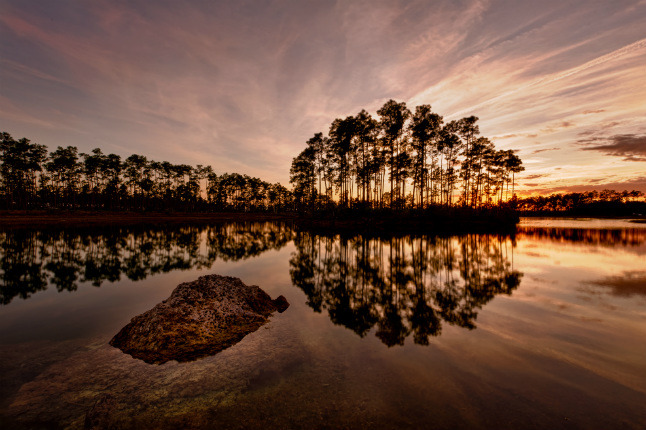An Expert Take On The Parks: Mel White
We may receive a commission on purchases made from links.
Mel White is the author of National Geographic's Complete National Parks of the United States, as well as the National Geographic Guide to Birding Hot Spots of the United States. His writing has appeared in the pages of National Geographic Traveler and National Geographic magazines. He's also written or contributed to more than 20 travel and nature guidebooks.
White was one of the only experts who was wiling to rank his favorite parks. Here are the 12 he chose:
1. Rocky Mountain National Park (#13 on the list)
Not just my favorite national park, but my favorite place on the planet. Staggering beauty, great wildlife, trails from easy strolls to endurance tests, and a wider range of habitats than many people expect. Mid-September is my favorite time, but early summer is nice, too. Do the Chasm Lake hike, but not on the day that I go.
2. Big Bend National Park (#20 on the list)
You can't be a birder and not visit Big Bend. (I am one, hence this high rating.) In fact, a 15-passenger van in the park is either a birdwatching tour group or a university geology class studying this chaotic textbook of earth's past. With the Rio Grande, the Chihuahuan Desert, and the Chisos Mountains, this is like three different parks in the same location. If you can make only one visit, make it in spring after a wet winter for a fantastic wildflower display.
3. Everglades National Park (#12 on the list)
Broiling heat, stupefying humidity, hellclounds of mosquitos, invasive species... What's not to love? I love: the diversity of wildlife from butterflies to reptiles, the subtropical flora unique in the United States, the chance to see a crocodile, the canoe trails, the wide-open spaces where nobody ever goes.
4. Acadia National Park (#3 on the list)
I've been here only once for a two-week visit, but it was the perfect time: fall after the crowds had thinned a bit, with hardwood foliage at peak color. The rocky coast, the lakes and the islands are highlights, and the famed carriage roads, while hardly wilderness trails, make it easy to see a lot of the park quickly and easily by bicycle. "Intimate" is an overused word for landscapes, but it applies here.
5. Great Smoky Mountains National Park (#17 on the list)
The enduring jewel of our now mostly devastated eastern hardwood ecosystem, with scattered patches of old-growth forest that escaped early 20th-century loggers. Spring wildflowers alone make a trip worthwhile. Don't let the "most-visited national park" title keep you away; most of those visitors never leave the roads. You have to work a little to find solitude here, but you can do it.
6. Grand Canyon National Park (#5 on the list)
No explanation needed. I'd rank it higher except for the fact that, for the average visitor, very little of its grandeur is practically accessible. That, of course, is both a bad and a good thing.
7. Yellowstone National Park (#1 on the list)
It's a toss-up whether the wildlife or the geologic weirdness ranks higher on the scale of wonders. I lean toward the latter, because there's no place on earth like Yellowstone's combination of thermal features, both ancient and contemporary. Read about its cataclysmic past before you explore it for a fuller appreciation.
8. Redwood National Park (#15 on the list)
You want to cry when you realize how much of this incredible forest existed before the timber companies found it. Console yourself at places like Lady Bird Johnson Grove and Howland Hill Road. Return to a smaller scale of the natural world by exploring the tidepools at Enderts Beach near Crescent City, just one of the park's many non-redwood habitats.
9. Saguaro National Park (#37 on the list)
I love Arizona's Sonoran Desert, even down to the way it smells at dawn in springtime. Surprisingly to many people, one of the best times to visit is during the summer "monsoon" season of localized rainstorms, when flowers bloom and birds nest. If only this place was bigger...
10. Theodore Roosevelt National Park (#44 on the list)
Certainly among the most underrated national parks, this site combines colorful badlands terrain, riparian habitat along the Little Missouri River, and wildlife both native and non (wild horses and longhorn cattle). The auto-tour route is very nice for casual visitors, but it's far better to hike one of the cross-country trails.
11. Petrified Forest National Park (#48 on the list)
Here's a park where it's really important to talk to rangers about areas off the beaten path. There's lots more to see than just the massive quartz logs, including Native American structures, odd geologic features and grand vistas of the Painted Desert.
12. Mammoth Cave National Park (#28 on the list)
It doesn't have as many spectacular cave formations as does Carlsbad Caverns, but the sheer scale of this cave system makes it impressive. I spent five days underground helping with an archeological survey and learning about the long and fascinating history of this cave, which was intensively used by Native Americans for centuries and then remained unknown for nearly two millennia, until around 1800.
